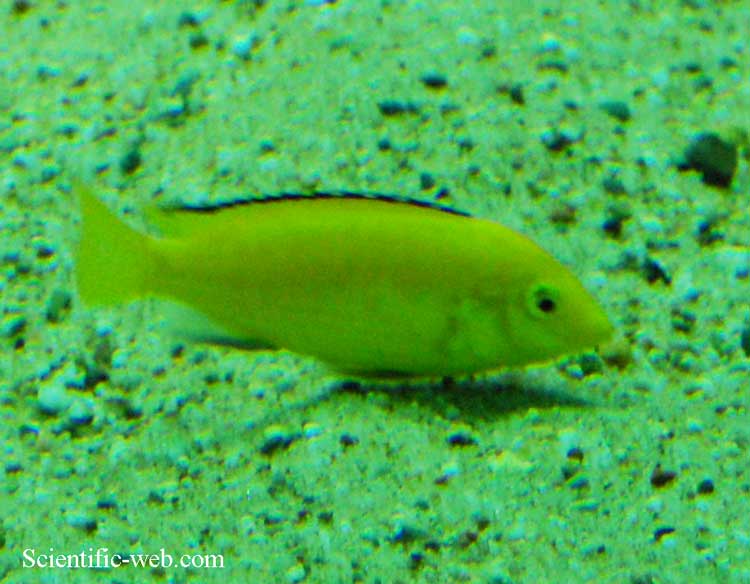
Labidochromis caeruleus
Superregnum : Eukaryota
Cladus: Unikonta
Cladus: Opisthokonta
Cladus: Holozoa
Regnum: Animalia
Subregnum: Eumetazoa
Cladus: Bilateria
Cladus: Nephrozoa
Superphylum: Deuterostomia
Phylum: Chordata
Subphylum: Vertebrata
Infraphylum: Gnathostomata
Megaclassis: Osteichthyes
Superclassis/Classis: Actinopterygii
Classis/Subclassis: Actinopteri
Subclassis/Infraclassis: Neopterygii
Infraclassis: Teleostei
Megacohors: Osteoglossocephalai
Supercohors: Clupeocephala
Cohors: Euteleosteomorpha
Subcohors: Neoteleostei
Infracohors: Eurypterygia
Sectio: Ctenosquamata
Subsectio: Acanthomorphata
Divisio/Superordo: Acanthopterygii
Subdivisio: Percomorphaceae
Series: Ovalentaria
Superordo: Cichlomorphae
Ordo: Cichliformes
Familia: Cichlidae
Subfamilia: Pseudocrenilabrinae
Tribus: Haplochromini
Genus: Labidochromis
Species: Labidochromis caeruleus
Name
Labidochromis caeruleus Fryer, 1956
Holotype: BMNH 1956.9.4.9. [Paratypes: BMNH 1956.9.4.10-11 (2), BMNH (4, 1 skeleton)].
Type locality: Nkata Bay, Lake Malawi [Lake Nyasa], southeastern Africa.
Synonyms
Labidochromis caeruleum Fryer, 1956
References
Fryer, G. 1956: New species of cichlid fishes from Lake Nyasa. Revue de Zoologie et de Botanique Africaines, 53(1-2): 81–91.
Poll, M. & J.-P. Gosse 1995: Genera des poissons d'eau douce de l'Afrique. Mémoire de la Classe des Sciences. Académie royale de Belgique. 9: 1–324.
Labidochromis caeruleus in FishBase,
Froese, R. & Pauly, D. (eds.) 2022. FishBase. World Wide Web electronic publication, www.fishbase.org, version 08/2021.
Vernacular names
Boarisch: Göwer-, Góiderner Labidochromis
Deutsch: Gelber Labidochromis
English: Electric yellow cichlid, Blue streak hap
Labidochromis caeruleus is a species of cichlid endemic to the central western coastal region of Lake Malawi in East Africa. It is also known as lemon yellow lab, the blue streak hap, the electric yellow or yellow prince, depending on the colour morph. A naturally occurring yellow-coloured variant from Lion's Cove is one of the most popular cichlids amongst aquarium hobbyists.
Electric yellows inhabit water with a pH between 7.8 and 8.9 and an ideal temperature range of 23–26 °C (73.4–78.8 °F). Large males may reach 15 centimetres (5.9 in) in length.
Reproduction
This species, like the Astatotilapia burtoni, is a maternal mouthbrooder, meaning the eggs are carried, hatch, and develop in the mother's mouth (buccal cavity), for about three weeks. These fish are ovophiles and the male will excavate a pit in the sand within his territory, in which the female lays the eggs; the female then takes these eggs into her mouth for fertilization.
Aquarium care
Electric yellows are peaceful compared to most other African cichlids. Despite this, like all cichlids from Lake Malawi, they are best kept in specialist cichlid aquariums with other Mbuna. As with most cichlids, electric yellows should not be kept with freshwater community aquarium species such as Zebra Danios or Neon Tetras, they may nip the finnage of other peaceful species, and are not recommended for freshwater community aquariums because of the differences in the natural habitats between African Lake cichlids and other fish species. This fish is more suited to an African lake cichlid community consisting of other Malawi species. In an aquarium setting, their natural habitat of rocks and caves should be emulated with a sandy substrate. Their diet should consist mostly of prepared cichlid pellets or flakes, supplemented with foods like krill, bloodworms, brineshrimp, and Spirulina flakes. Refrain from feeding these cichlids feeder goldfish, as they are likely carrying diseases that will cause harm to your cichlids.
See also
Mbuna
List of freshwater aquarium fish species
References
Wikimedia Commons has media related to Labidochromis caeruleus.
"Labidochromis caeruleus". Integrated Taxonomic Information System. Retrieved June 22, 2005.
Froese, Rainer, and Daniel Pauly, eds. (2005). Labidochromis caeruleus in FishBase. May 2005 version.
Konings, A.; Kazembe, J. (2018). "Labidochromis caeruleus". IUCN Red List of Threatened Species. 2018: e.T61090A148673526. doi:10.2305/IUCN.UK.2018-2.RLTS.T61090A148673526.en. Retrieved 20 November 2021.
Retrieved from "http://en.wikipedia.org/"
All text is available under the terms of the GNU Free Documentation License

